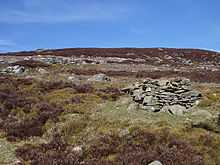Driven grouse shooting
.jpg)
Driven grouse shooting is a field sport of the United Kingdom. It is popular because it provides a challenge due to the rapid flight of the grouse. The grouse shooting season extends from 12 August, often called the "Glorious Twelfth", to 10 December each year. Shooting takes place on grouse moors, areas of moorland in northern England and Scotland.
Description

The name 'driven grouse shooting' refers to the way in which the grouse are driven towards the hunters (termed 'guns') by beaters. A shooting party usually includes 8–10 guns who stand in a line in the butts—hides for shooting spaced some 20–30 m apart, screened by a turf or stone wall and usually sunken into the ground to minimise their profile—to shoot the grouse in flight.[1] There is a strict code of conduct governing behaviour on the grouse moor for both safety and etiquette. Grouse shooting can also be undertaken by 'walking up' grouse over pointers, or by flushing the birds with other dogs.[2]
Grouse management
The Red Grouse is a medium-sized bird of the grouse family or subfamily which is found in heather moorland in Great Britain and Ireland. It is usually classified as a subspecies of the Willow Grouse, but is sometimes considered to be a separate species Lagopus scoticus. It is also known as the moorfowl or moorbird. The grouse can fly at up to 130 km/h (81 mph).[3]
To create a healthy grouse population, gamekeepers employ heather burning techniques. This involves burning patches of heather on the moorland. A burnt patch allows fresh shoots to come through which are ideal nutrition for grouse. Burning is done in patches so that there is a variety of heather heights. While the short new shoots provide food, the taller, older heather provides cover and shelter for the grouse. Not only does heather burning help the grouse population thrive but it encourages other wildlife by creating a variety of habitats in moorland areas.[4]
Economics

Rural communities benefit from grouse shooting each year. A parish survey around Blanchland, Northumberland, has found that 55 per cent of people are either directly or indirectly involved in grouse shooting and that increased guest numbers in the four-month shooting season push up the hotel's average occupancy rate from 50 to 65 per cent per year.[5][6] The grouse shooting industry has a big role in helping maintain, restore and preserve the local landscape. Grouse is also served in many local pubs, hotels and restaurants, boosting the hospitality industry.[4]
Some key statistics include:
- One keeper looks after approx. 3,500 acres (14 km2).
- Managers aim to hold 16 shootings days per 7,000 acres (28 km2).
- The fixed annual cost of running a grouse moor with two keepers is approx. £75,000.
- Each shooting day costs £1,800 to run with 30 beaters and pickers up @ £35 per day per person, nine loaders @ £50 per day and fuel for five vehicles @ £60 per tank.
- Potential revenue from let shooting is £120 per brace (a brace, in hunting, is two birds) with an average of 150 brace shot per day. Birds sold to a game dealer can fetch £4 per brace.
- Visiting guns spend in rural areas per shooting day: £100 per person dinner, bed and breakfast (full party of 9 guns = £1,800 including partners), lunch for nine (£20 per head) and further unknown expense on fuel, gun equipment, shopping, etc.[7]
Opposition
The driven grouse shooting industry has been criticised by some conservation bodies for harming moorland habitats and for persecuting predators, particularly the hen harrier, which preys on grouse chicks. The RSPB has called for shoots to be licensed,[8] and former RSPB Conservation Director Dr Mark Avery raised a petition calling for ban on the practice[9] that, as of December 2014, had attracted over 20,000 signatures.[10]
References
- ↑ Blakeley, Peter F (2012). Wingshooting. Stackpole Books. pp. 116, 125. ISBN 978-0-8117-0566-0.
- ↑ Grouse Shooting
- ↑ "UK: Driven and Walked up Grouse Shooting". WhereWiseMenShoot Limited. 2008. Retrieved 2013-01-06.
- ↑ 4.0 4.1 "Grouseshooting + great grouse recipe". fieldsportschannel.tv. Retrieved 29 October 2012.
|first1=missing|last1=in Authors list (help) - ↑ Grouse Shooting Benefits Rural Communities — The Herald
- ↑ How Grouse Shooting Helps Rural Economies — Telegraph
- ↑ Moorland Association
- ↑ Harper, Martin (24 June 2014). "Why it’s time to license driven grouse shooting". RSPB. Retrieved 2 September 2014.
- ↑ "Grouse Shooting & Hen Harriers Guide". Game & Wildlife Conservation Trust. Retrieved 2 September 2014.
- ↑ "e-petition: Ban driven grouse shooting". http://epetitions.direct.gov.uk/. Retrieved 2 September 2014.
| ||||||||||||||||||||||||||||||||||